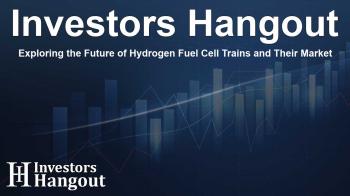Exploring the Future of Hydrogen Fuel Cell Trains and Their Market

The Expanding Hydrogen Fuel Cell Train Market
In recent years, the global hydrogen fuel cell train market has garnered significant attention as advancements in sustainable transportation technology continue to thrive. According to recent analyses, the hydrogen fuel cell train market is estimated to reach a size of $3.45 billion by 2030, a notable increase from just $1.45 million in 2022. This represents a remarkable compound annual growth rate (CAGR) of 11.5% from 2022 to 2030.
Market Drivers and Opportunities
The transportation sector is a major contributor to global carbon emissions, primarily due to the reliance on fossil fuels. This environmental predicament underscores the necessity for cleaner alternatives, and hydrogen-powered trains present a promising solution. These trains not only operate efficiently but also contribute to a significant reduction in air pollution. Governments worldwide recognize this trend and are laying the groundwork to enhance hydrogen fuel cell technology in the transportation sector.
Key Players in the Hydrogen Train Industry
Several major companies are leading the charge in developing hydrogen fuel cell trains. Industry giants like Talgo, Alstom, Ballard Power Systems, and CRRC Corporation are spearheading innovative projects focused on hydrogen technology. Their efforts aim to elevate public transportation by providing environmental-friendly options that adhere to growing sustainability mandates.
Understanding Hydrogen Fuel Cell Technology
At the heart of these trains is hydrogen fuel cell technology, which works through an electrochemical reaction between hydrogen and oxygen, producing electricity and water vapor as byproducts. This ensures that hydrogen trains emit no harmful pollutants, making them an efficient and green alternative to traditional diesel-powered trains. The adoption of such technology is vital for global targets aimed at reducing carbon footprints.
Challenges Facing the Market
Despite the promising outlook, the hydrogen fuel cell train market isn't without challenges. Infrastructure requirements for refueling hydrogen trains are substantial, necessitating significant investments. Furthermore, consumers and operators alike must be educated about the benefits of transitioning to hydrogen-powered systems, which could affect adoption rates.
Environmental Impact and Sustainability
There is an increasing global awareness regarding environmental concerns and the urgency to reduce greenhouse gas emissions. The rise in CO2 emissions from the transportation sector has prompted calls for immediate action. In recent statistics, projections indicated that such emissions reached 8.25 gigatonnes in one year, illustrating the pressing need for sustainable practices in transportation.
Regional Insights into Market Growth
Europe currently dominates the hydrogen fuel cell train market, boasting a substantial revenue share. Meanwhile, the Asia Pacific region is projected to exhibit the highest growth trajectory, with a CAGR of 12.2% anticipated from 2023 to 2031. The growing momentum in Asia is influenced by urbanization, industrialization, and increasing investment in renewable energy solutions.
Technological Innovations Transforming the Sector
Continuous innovation in hydrogen fuel cell technology enhances the performance of these trains. Efficiency improvements mean they deliver quicker speeds, with operational limits of up to 140 km/h and a capability to travel 1,000 km on a single refill. Such advancements position hydrogen fuel cell trains as a valuable asset in modern transportation networks.
Future Outlook and Trends
As the world embraces a shift towards sustainable practices, the hydrogen fuel cell train market is poised for growth. Companies are investing in research and development to refine hydrogen fuel cells, while partnerships with governmental bodies aim to propel infrastructure developments, ensuring adequate support for these advanced transportation systems.
Frequently Asked Questions
What is the expected growth of the hydrogen fuel cell train market?
The hydrogen fuel cell train market is projected to reach $3.45 billion by 2030, growing at a CAGR of 11.5% from 2022.
How does hydrogen fuel cell technology work?
Hydrogen fuel cell technology generates electricity through an electrochemical reaction between hydrogen and oxygen, producing water vapor as the only byproduct.
What are the benefits of hydrogen-powered trains?
Hydrogen-powered trains are eco-friendly, emitting no harmful pollutants, and are more efficient than traditional diesel engines, supporting global sustainability goals.
Which regions are leading in the hydrogen fuel cell train market?
Europe currently leads the market, followed closely by the Asia Pacific region, which is expected to showcase rapid growth.
What companies are key players in the hydrogen fuel cell train market?
Major players include Talgo, Alstom, Ballard Power Systems, and CRRC Corporation, all of whom are contributing significantly to the market's development.
About The Author
Contact Owen Jenkins privately here. Or send an email with ATTN: Owen Jenkins as the subject to contact@investorshangout.com.
About Investors Hangout
Investors Hangout is a leading online stock forum for financial discussion and learning, offering a wide range of free tools and resources. It draws in traders of all levels, who exchange market knowledge, investigate trading tactics, and keep an eye on industry developments in real time. Featuring financial articles, stock message boards, quotes, charts, company profiles, and live news updates. Through cooperative learning and a wealth of informational resources, it helps users from novices creating their first portfolios to experts honing their techniques. Join Investors Hangout today: https://investorshangout.com/
The content of this article is based on factual, publicly available information and does not represent legal, financial, or investment advice. Investors Hangout does not offer financial advice, and the author is not a licensed financial advisor. Consult a qualified advisor before making any financial or investment decisions based on this article. This article should not be considered advice to purchase, sell, or hold any securities or other investments. If any of the material provided here is inaccurate, please contact us for corrections.

